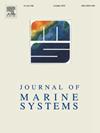Linking oceanographic conditions to foraging behaviour of southern elephant seals by characterising mid-trophic levels with an animal-borne echosounder
IF 2.5
3区 地球科学
Q2 GEOSCIENCES, MULTIDISCIPLINARY
引用次数: 0
Abstract
Changes in Southern Ocean thermohaline conditions could drive changes in phytoplankton community composition propagating into upper-trophic levels, from the abundance and composition of mid-trophic level communities to foraging behaviour of top marine predators. Studies exploring the ecological consequences of such processes are largely limited by our in-situ observation capacity. The simultaneous deployment of a miniature sonar tag, combining active acoustics and movement sensors, with oceanographic tags on 4 adult female southern elephant seals from the Kerguelen Islands provided in-situ measurements of thermohaline conditions, mid-trophic level abundance and seal-foraging behaviour. In addition, chlorophyll-a concentration and relative abundance of different phytoplankton size classes were assessed from satellite ocean colour data. This study reveals that east of the Kerguelen Islands, the subsurface scatterer abundance (related to mid-trophic level organisms) assessed by the sonar tag was partly positively linked to surface satellite-derived microphytoplankton biomass, especially in colder waters and frontal zones. Female elephant seals were found to dive shallower with higher subsurface scatterer abundance, which indicated a better prey accessibility, and were found to catch more prey when foraging in shallow and/or frontal zones. This study highlights the usefulness of the sonar tag, deployed on deep-diving elephant seals, to link thermohaline conditions and phytoplankton community composition in mid-trophic levels. Our result suggests that in addition to phytoplankton biomass, mid-trophic level abundance and distribution might be key factors in influencing top-marine predator foraging performances.
通过动物传播的回声探测仪表征中等营养水平,将海洋条件与南象海豹的觅食行为联系起来
南大洋温盐条件的变化可以驱动浮游植物群落组成的变化,从中营养级群落的丰度和组成到顶级海洋捕食者的觅食行为。探索这些过程的生态后果的研究在很大程度上受到我们现场观测能力的限制。研究人员将结合主动声学和运动传感器的微型声纳标签与海洋标签同时部署在4只来自凯尔盖伦群岛的成年雌性南象海豹身上,对温盐条件、中营养水平丰度和海豹觅食行为进行了现场测量。此外,利用卫星海洋颜色数据评估了不同浮游植物大小类别的叶绿素-a浓度和相对丰度。该研究表明,在Kerguelen群岛东部,声纳标签评估的地下散射体丰度(与中营养级生物相关)与地表卫星衍生的微型浮游植物生物量部分正相关,特别是在较冷的水域和锋面区。雌海象的潜深较浅,潜深下散射丰度较高,猎物可及性较好,在浅海和(或)额区觅食时捕获的猎物较多。这项研究强调了部署在深潜海象身上的声纳标签的实用性,它可以将温盐条件和中等营养水平的浮游植物群落组成联系起来。结果表明,除浮游植物生物量外,中等营养水平的丰度和分布可能是影响顶级海洋捕食者觅食性能的关键因素。
本文章由计算机程序翻译,如有差异,请以英文原文为准。
求助全文
约1分钟内获得全文
求助全文
来源期刊

Journal of Marine Systems
地学-地球科学综合
CiteScore
6.20
自引率
3.60%
发文量
81
审稿时长
6 months
期刊介绍:
The Journal of Marine Systems provides a medium for interdisciplinary exchange between physical, chemical and biological oceanographers and marine geologists. The journal welcomes original research papers and review articles. Preference will be given to interdisciplinary approaches to marine systems.
 求助内容:
求助内容: 应助结果提醒方式:
应助结果提醒方式:


